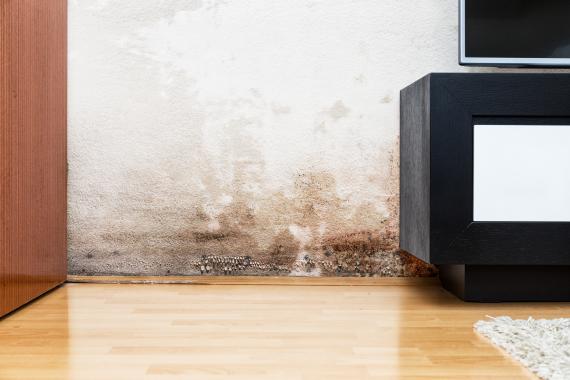Summary
– Accidental causes of humidity: what are they?
– Other causes of humidity in the home
The causes of moisture are numerous and often difficult to determine.
Only a professional can make the right diagnosis to propose the appropriate treatment(s).
Accidental causes of humidity: what are they?
Accidental causes are one of the primary sources of humidity inside homes.
These accidental causes are:
– Water damage:
◦ slow leaks: sanitary facilities, bathtub, dishwasher;
◦ problems with pipes and water drain such as broken or clogged pipes, etc…;
◦ faulty construction;
◦ wear and tear: joints in the bathroom etc…
– A flood: the rupture of a roadway pipe, flooded river, etc…
The consequences of water damage can be significant: rotten parquet flooring, damaged beams, and more.
Signs that should alert you

Most often, a leak is not visible to the naked eye. It may take several days or weeks before you discover it. However, some signs, such as your bathroom floor not drying out, can give you a warning.
Accidental causes: what to do?
In case of a leak or a broken pipe, the first thing to do is turn off the water immediately. If you are in a building and the leak comes from another apartment, you must determine the leak’s origin as soon as possible. If your neighbor is not home, notify the janitor and the trustee.
In the event of flooding, only professionals can dry out your home and accurately diagnose the work that needs to be done afterward.
Warning: it is necessary to notify your insurance company as soon as possible, whether you are a homeowner or a tenant. Your insurance company will call in an expert to determine the cause of the damage and compensate you.
If you notice humidity problems in your home, contact a specialist. He is the only one who can accurately diagnose the cause of humidity in your home and suggest the appropriate treatment(s).
Among the leading causes of humidity in the house are:
– poor ventilation that does not allow the moisture to evacuate efficiently from your home;
– infiltration of rainwater into the walls or foundations by hydrostatic pressure;
– capillary action in the walls;
– hydrostatic pressure that leads to lateral infiltrations at the foundation level.
Consequences of humidity on health
Humidity’s health consequences leave no doubt: research in Canada and Belgium has medically demonstrated that the consequences can be infectious and toxic.
Symptoms triggered by humidity
Excessive humidity triggers chain reactions in people exposed to it:
– skin irritation that may result in more or less pronounced eczema.
– headaches, an accentuation of tiredness;
– nausea, even vomiting;
– in the respiratory tract: cough, asthma, rhinitis, shortness of breath, etc.;
– eye irritation;
– development of allergies.
Studies have shown that:
– the virulence of the impact on health is directly related to the time of exposure to the spores: spores are small, highly volatile particles that enter into the composition of a fungus;
– the height of the mold in relation to the respiratory tract also plays an important role. If the stains are at the nose’s level, the contamination and the health effects are much more direct than if the stain was behind a piece of furniture, for example.
Fight against humidity pathologies
Fighting against humidity can therefore become a real necessity. Nothing very complicated if the affected areas are not very large:
– Clean all the mold with a cloth soaked in soapy water: be careful not to get the fabric wet either.
– Wipe the surface with a clean damp cloth.
– Dry with a dry cloth.
– Ventilate the room to accelerate drying.
– Get rid of moldy or damaged objects or fabrics.
Note: It is essential to wear a dust mask, goggles, and rubber gloves to avoid exposure to mold spores during the entire operation.

I don’t even know the way I ended up right here, but I believed this publish was once good. I don’t recognise who you’re however certainly you’re going to a well-known blogger for those who aren’t already 😉 Cheers!